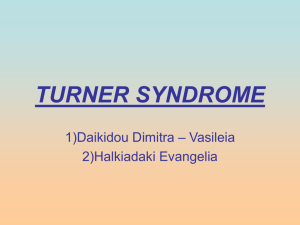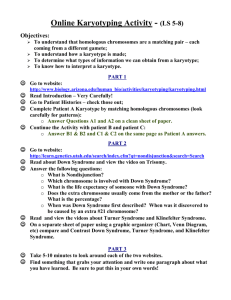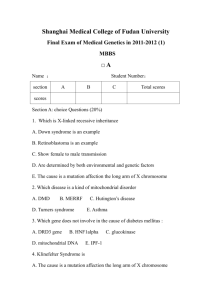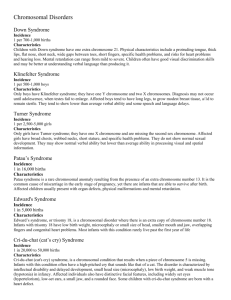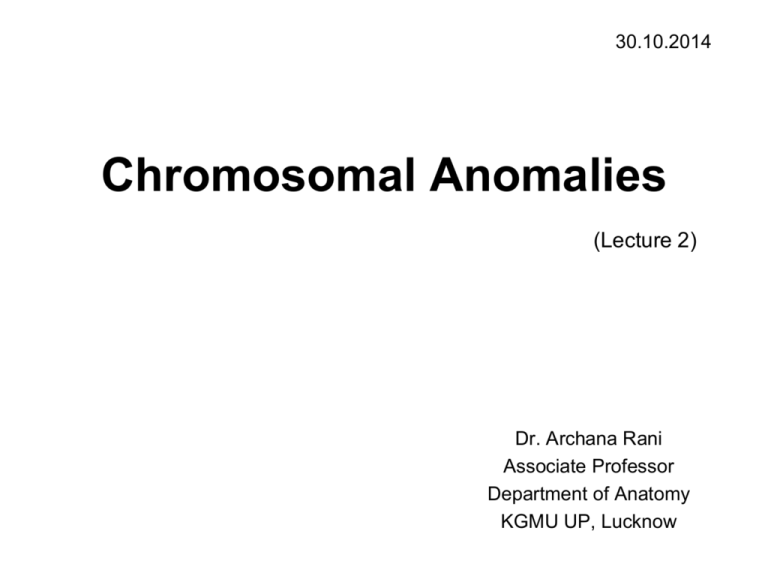
30.10.2014
Chromosomal Anomalies
(Lecture 2)
Dr. Archana Rani
Associate Professor
Department of Anatomy
KGMU UP, Lucknow
Trisomy of Sex Chromosomes
• Klinefelter syndrome
• Triple X syndrome
• Double Ysyndrome
Klinefelter Syndrome
• Chromosome complement: 47,XXY
• Phenotype: Male
• Incidence: 1:1000
Features of Klinefelter Syndrome
• Tall stature; thin build;
long lower limbs
• Testicular atrophy
• Female pattern of pubic
hair
• High pitched voice
• Infertility
(aspermatogenesis)
• Gynaecomastia
• Low level of intelligence
• Serum testosterone
levels low to normal
• FSH and LH levels very
high
• Sex chromatin positive
Klinefelter syndrome: Karyotype
Klinefelter Syndrome
Triple X Syndrome (Superfemale)
• Chromosome complement: 47,XXX
• Phenotype: Female
• Incidence: 1:1000
Features of Triple X Syndrome
• Normal in appearance
• Difficulty in speech,
learning and emotional
responses
• Mild mental retardation
in 15-25% cases
• Two sex chromatin
Barr bodies
• Infertility
•
•
•
•
•
Wide-set eyes
Amenorrhoea
Expressionless face
Enamel hypoplasia
Deficient
language
skills
• Delayed development
of motor skills
Superfemale: Karyotype
Superfemale
Double Y Syndrome
• Chromosome complement: 47,XYY
• Phenotype: Male
• Incidence: 1:1000
Features of Double Y Syndrome
• Normal in appearance
• Tall stature
• Aggressive behaviour
• Problems in
development
motor
and
language
Monosomies of Chromosomes
• Presence of only one member of a chromosome
pair in a karyotype
• More detrimental than equivalent trisomy
• Can involve autosomes or sex chromosomes
• Usually abort spontaneously
• Monosomy of X chromosome results in XO
condition called Turner syndrome
Turner Syndrome
• Chromosome complement: 45,XO
• Phenotype: Female
• Incidence: 1:5000-8000
Features of Turner Syndrome
• Short statured female
• Sexual infantilism with
primary amenorrhoea
and sterility
• Short, webbed neck
• Prominent ears with
defective hearing
• Small mandible
• Defective vision
Features of Turner Syndrome
•
•
•
•
•
•
•
•
Epicanthal folds
Low posterior hair line
Cubitus valgus
Broad chest with widely
spaced nipples
Cardiovascular
anomalies
Hyperconvex
finger
nails
Pigmented nevi
Sex chromatin negative
Turner Syndrome: Karyotype
Turner Syndrome
Structural Chromosomal Abnormalities
• Results from chromosome breakage
• Followed by reconstitution in an
abnormal combination
• Breaks in any chromosome may be
induced by various factors
Structural Chromosomal Abnormalities
• Deletion (Deficiency)
• Inversion
• Translocation
• Isochromosome
• Ring Chromosome
Deletion
• Loss of a (generally small) segment of
chromosome
A B C D E F G
A B D E F G
C
Deletion
• Arise through
spontaneous breakage
– some
chromosomes have
fragile spots
– radiation, UV,
chemicals, viruses
may increase
breakage
Deletion
• May arise through
unequal crossing over
A B
C D
E
F
G
x
A B
A B
C D E G
Deletion
C D
A B
E
F
G
C D
E
F F G
Duplication
Deletions in Humans
• Cri-du-chat syndrome
– Micro deletion of chromosome 5
• Di-George syndrome
– Micro deletion of chromosome 22
• Schizophrenia & Obsessive Compulsive Disorder
– Micro deletion of chromosome 22 associated
• Angelman syndrome
– Micro deletion of chromosome 15
• Prader-Willi syndrome
– Micro deletion of chromosome 15
Cri-du-chat syndrome
•
•
•
•
•
•
•
•
•
•
1st autosomal deletion described
Characteristic cat-like cry, which disappears with age
Microcephaly
Severe mental retardation
Congenital heart disease
Hypertelorism (widely separated eyes)
Low birth weight and poor growth
Severe cognitive, speech, and motor delay
Behavioral problems
Excessive drooling
Cri-du-chat syndrome
Prader-Willi and Angelman Syndromes
Prader-Willi Syndrome
• Lack of muscle tone in
newborn
• Poor swallowing reflex
• As adult - gross obesity
• Mean I.Q. ~ 50
• Microdeletion of 15
Angelman Syndrome
• Developmentally
delayed
• Jerky movements
• Stiff, fixed smile
• Uncontrolled laughter
• Abnormal E.E.G.,
epilepsy
• Microdeletion of 15
Inversion
• 180o reversal of chromosome segment
A
B
C
D
E
F
G
H
I
J
K
D
I
J
K
180O
A
B
C
H
G
F
E
Inversion
• Produced through breakage and
reassociation of chromosome
D
E
C
A
B
F
G
Inversion
• Produced through breakage and
reassociation of chromosome
D
E
C
A
B
F
G
Types of Inversion
Paracentric
Pericentric
Translocation
• Exchange of segments between nonF
homologous chromosomes
E
L
M
D
N
O
C
B
A
P
Q
Translocation
A
B
C
Q
O
P
N
D
M
E
L
F
Isochromosome
• Centromere of the
chromosome divides
transversely instead
of longitudinally
• One arm is missing
and the other arm
duplicated
Ring Chromosome
• Occurs due to loss of
both the ends of a
chromosome
• The broken ends rejoin
to
form
a
chromosome
• Rare anomaly
ring-like
Robertsonian Changes
• Fusion
two chromosomes join to form one
• Fission
one chromosome splits to form two
REFERENCES
1. Essentials of Anatomy for Dentistry
Students,1st Edition.
2. Langman’s Medical Embryology,11th
Edition.
3. Human Embryology, 5th Edition.
MCQs
1. Klinefelter syndrome is associated with
chromosome complement:
a) 47,XXX
b) 47,XXY
c) 47,XYY
d) 47,YYY
MCQs
2. Testicular atrophy is associated with:
a) Triple X syndrome
b) Double Y syndrome
c) Turner syndrome
d) Klinefelter syndrome
MCQs
3. Sex chromatin negative is a characteristic
feature of:
a) Triple X syndrome
b) Down syndrome
c) Turner syndrome
d) Klinefelter syndrome
MCQs
4. All of the following are trisomy of sex
chromosomes except:
a) Turner syndrome
b) Klinefelter syndrome
c) Triple X syndrome
d) Double Y syndrome
MCQs
5. Partial deletion of short arm of chromosome
5 is a feature of:
a) Angelman syndrome
b) Prader -Willi syndrome
c) Cri-du-chat syndrome
d) All of the above

